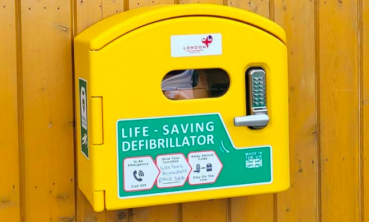Grant Information Hotline
SAVE LIVES – APPLY NOW >
Grant Information Hotline
SAVE LIVES – APPLY NOW >
11 Jun 2024

In the world of emergency medical equipment, few tools hold as much potential to save lives as the defibrillator. These devices, available in both automated external (AED) and manual variants, are designed to deliver a crucial shock which restores a patient’s heart back to normal heart rhythm during cardiac arrest. However, their effectiveness is reliant on proper upkeep and maintenance. In this blog post, we will explore in detail the steps necessary to ensure your defibrillator remains in optimal condition and ready to use when seconds count with our defibrillator maintenance guide.
What is a defibrillator?
A defibrillator is a device that gives a shock of electricity to the heart. It helps to get the heart beating again when someone is in cardiac arrest and their heart has stopped. They might also be called a defib, an AED (Automatic External Defibrillator) or a PAD (Public Access Defibrillator). Start your defibrillator Project now.
Why is upkeep so important?
Ensuring the pads and batteries of a defibrillator are in optimal condition is prime importance for its effectiveness in saving lives during cardiac emergencies. Here is why:
Immediate availability:
During a sudden cardiac arrest, every second counts. Having functional electrode pads and fully charges batteries ensures that the defibrillator is ready for immediate use without any delays. Any delay in accessing or using the defibrillator due to faulty pads or depleted batteries can significantly reduce the chances of survival for the victim.
Effectiveness of shock delivery:
The electrode pads are responsible for delivering the electric shock to the patient’s chest to restore normal heart rhythm. If the pads are expired, damaged or attached incorrectly, this can compromise the effectiveness of the shock delivery and decrease the likelihood of successful defibrillation.
Patients’ safety:
using expired or defective electrode pads or batteries can cause safety risks to both the patients and the rescuer. Properly functioning equipment minimises the risk of complications or injuries during the defibrillation process, ensuring the safety of everyone involved in the rescue.
Routine checks and inspections:
Regular maintenance is essential to defibrillator upkeep. Incorporating routine checks and inspections into your maintenance schedule is crucial to ensuring the devices reliability. Here are some key areas to focus on:
Visual inspection:
Perform regular visual inspections of the device, paying close attention to the exterior for any signs of wear and tear. Focus on the electrode pads and cables for integrity, ensuring they are properly connected and free from any damage.
Battery Check:
The battery is the “Heart” of the defibrillator. Regularly check the battery status indicator to ensure that it is fully charged and replace it if needed. A defibrillator with a depleted battery will not be effective during an emergency.
Electrode pads:
Check the expiration date of the electrode pads and replace them as needed. Pads have an expiration date of 2 years. Expired pads may not adhere properly to the patient’s skin which can have an adverse impact on the effectiveness of the shock delivery to the heart.
Self-test function:
Our defibrillators come with a self-test function. Make it a habit to regularly run this test to ensure that all components are functioning correctly. Follow our partners (Defib World) guidelines for interpreting the results of the self-test.
Storing a defibrillator:
Storing a defibrillator properly is crucial to ensure its functionality and accessibility during emergencies. Here are some guidelines for safe defibrillator storage:
Indoor storage:
Outdoor storage:
Avoid incorrect storage.
You can contact our defibrillator team who will help you to choose a defibrillator that’s right for you. They’re available by phone, email or online chat from 8am to 4pm, Monday to Friday.
Email: info@londonhearts.org
Tel: 020 7043 2493
Apply for a Defibrillator: Apply For A Defibrillator | London Hearts



